Mexican water flea: not only live food for aquarium fish and other aquatic animals
Mexican freshwater shrimp (Hyalella azteca) is an ideal live food for aquarium fish, especially compared to the demanding European species of the genus Gammarus. Native to North America, this crustacean is undemanding in terms of oxygen and room temperature. Find out how to turn freshwater shrimp into "live vitamin bombs" and ensure a high-quality and stimulating food supply for your fish.
Mexican amphipod (Hyalella azteca) is a species of freshwater crustacean belonging to the amphipod species complex (Amphipoda) native to Central and North America, where it inhabits lakes and rivers and its range extends to the edge of the forest in northern Canada.
Males reach a length of 8 mm and females 6 mm. It is a good indicator of water pollution, but its oxygen requirements are significantly lower than those of Central European amphipods (Amphipoda) of the genus Gammarus. In our area, there are three representatives of the genus Gammarus - the ribbed amphipod (Gammarus roeselii), the stream amphipod (Gammarus fossarum), and the common amphipod (Gammarus pulex). All three species of amphipods are sensitive to water temperature and its oxygen content. Their breeding in aquariums is problematic. Therefore, let us get to know the Mexican amphipod better, as its breeding and rearing is very simple, and once the colony is established, it is also very productive.
Starting the breeding of amphipods
I ordered my first stock in January 2020. I had known about amphipods for a while, but I still couldn’t manage to come across them in advertisements. Until I finally succeeded. Before the planned arrival of the amphipods, I prepared them a 30-liter tank, which I placed on the windowsill. The aquarium is still there today. The tank was set up very simply. A couple of plants and a handful of dry leaves. Later, I added a simple aerator or bubble maker. The plants quickly took off, and after the invasions of amphipods, only bare twigs remained. During the first water change, I overlooked the size of the small amphipods and thus siphoned them out. After this experience, I change the water in such a way that I let it flow through a fine mesh. This captures all developmental stages, which I then shake back into the aquarium.
Feeding
Amphipods consume practically everything you give them. They are not picky about food. The basis of their diet consists of dried beech and oak leaves (brown, usually collected in autumn), blanched nettles, potatoes (raw), carrots, and all dried and frozen fish food. I follow the motto that when I feed the amphipods a varied and vitamin-rich diet, they are equally nutritious for the fish. In other words, they become living vitamin bombs.
You can only give them dry leaves, and occasionally some vegetables, but they won’t be as reproductive, and they will be less nutritious for the fish. Previously, I used to give the amphipods cucumber, but from a nutritional perspective, it offers them nothing. Cucumber is largely made of water and, to a lesser extent, fiber. We can provide that in another form. However, it has one advantage: when I need to attract the amphipods, I place a slice on the surface, and in a moment, the cucumber is full of amphipods.
Breeding
As I mentioned above, I raise them in a tank placed on the windowsill. The advantage is that in summer, when the sun shines into the aquarium, green algae begin to form to such an extent that you cannot see into the aquarium. This cloudy water suits them because they filter it and thus receive another source of food.
Temperature fluctuations do not bother them. Room temperature is sufficient for them. The water should be neutral because they are “water shrimp” and they do not thrive in soft water. Their sensitivity to chlorine is high, and we should keep that in mind when changing the water. During the change, we can use water from the aquarium or standing water. Since I have well water, I give it directly from the tap.
Amphipods like to hide. Dry leaves, which they consume, can serve as shelters, and it is necessary to constantly replenish them. Additionally, a sponge filter, a layer of detritus that they create, or that we provide from an aquarium that we have siphoned can also be used. Scraps can also be used. This gives the amphipods additional space. The advantage of scraps is that when I want to catch the amphipods for feeding, I simply pull the scraps out of the water and transfer them to the feeding dish.
It is necessary to aerate the water, especially in summer, to prevent suffocation. With good breeding, they will multiply beyond the size of the aquarium, so we must artificially supplement the air in the water.
If we do not want to introduce amphipods into some aquariums, we feed them carefully. Even with all precautions, some amphipods will still escape the attention of the fish.
I have amphipods in all my tanks. Occasionally, I release them intentionally to support the colony in that particular aquarium. The amphipods serve as a food supply during vacation time. Sometimes I deliberately do not feed the fish so that they can hunt. And also to provide them with enrichment in the aquarium and not just “stand” in one place waiting for something to fall into their mouths.
Their enormous advantage is their lively movement. Compared to other live foods, they are not easily caught. They force the fish to expend some effort to catch them. In other words, the fish must “earn” it.
For anyone wanting to provide their fish with quality and live food, I can only recommend amphipods.
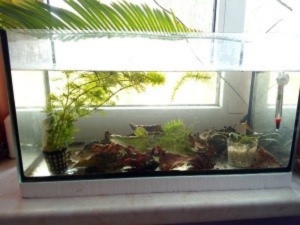
Set up aquarium before releasing amphipods.
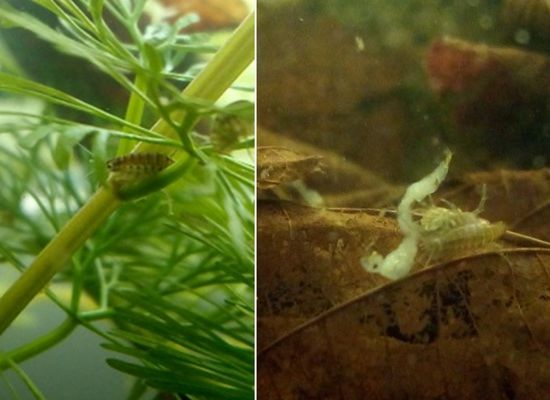
They are not picky about food. On the left, a mayfly larva.
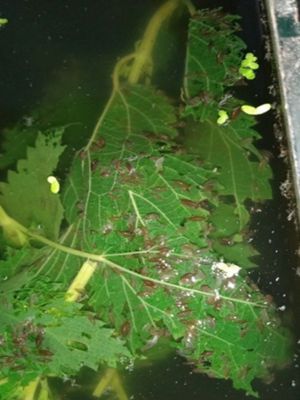
Blanched nettles, a sought-after food.
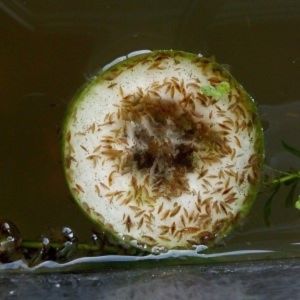
An example of how they can be easily caught.
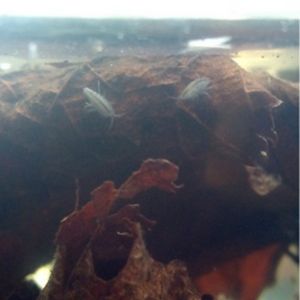
Leaves form the basis of their diet.

